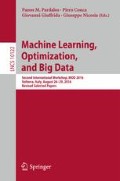Abstract
This study establishes interoperability among electronic medical records from 737 healthcare sites and performs machine learning for best practice discovery. A mapping algorithm is designed to disambiguate free text entries and to provide a unique and unified way to link content to structured medical concepts despite the extreme variations that can occur during clinical diagnosis documentation. Redundancy is reduced through concept mapping. A SNOMED-CT graph database is created to allow for rapid data access and queries. These integrated data can be accessed through a secured web-based portal. A classification model (DAMIP) is then designed to uncover discriminatory characteristics that can predict the quality of treatment outcome. We demonstrate system usability by analyzing Type II diabetic patients. DAMIP establishes a classification rule on a training set which results in greater than 80% blind predictive accuracy on an independent set of patients. By including features obtained from structured concept mapping, the predictive accuracy is improved to over 88%. The results facilitate evidence-based treatment and optimization of site performance through best practice dissemination and knowledge transfer.
Access this chapter
Tax calculation will be finalised at checkout
Purchases are for personal use only
References
Jensen, P.B., Jensen, L.J., Brunak, S.: Mining electronic health records: towards better research applications and clinical care. Nat. Rev. Genet. 13(6), 395–405 (2012)
Park, H., Hardiker, N.: Clinical terminologies: a solution for semantic interoperability. J. Korean Soc. Med. Inform. 15(1), 1–11 (2009)
Rosenbloom, S.T., et al.: Interface terminologies: facilitating direct entry of clinical data into electronic health record systems. J. Am. Med. Inform. Assoc. 13(3), 277–288 (2006)
Donnelly, K.: SNOMED-CT: the advanced terminology and coding system for eHealth. Stud. Health Technol. Inform. 121, 279 (2006)
McDonald, C.J., et al.: LOINC, a universal standard for identifying laboratory observations: a 5-year update. Clin. Chem. 49(4), 624–633 (2003)
Liu, S., et al.: RxNorm: prescription for electronic drug information exchange. IT Prof. 7(5), 17–23 (2005)
Bodenreider, O.: The unified medical language system (UMLS): integrating biomedical terminology. Nucleic Acids Res. 32(suppl 1), D267–D270 (2004)
Hernandez, P., et al.: Automated mapping of pharmacy orders from two electronic health record systems to RxNorm within the STRIDE clinical data warehouse. American Medical Informatics Association (2009)
Carlo, L., Chase, H.S., Weng, C.: Aligning structured and unstructured medical problems using umls. American Medical Informatics Association (2010)
Patel, C.O., Cimino, J.J.: Using semantic and structural properties of the unified medical language system to discover potential terminological relationships. J. Am. Med. Inform. Assoc. 16(3), 346–353%@ 1067–5027 (2009)
Gallagher, R.J., Lee, E.K.: Mixed integer programming optimization models for brachytherapy treatment planning. In: Proceedings of the AMIA Annual Fall Symposium. American Medical Informatics Association (1997)
Haffner, S.M.: Epidemiology of type 2 diabetes: risk factors. Diab. Care 21(Suppl. 3), C3–C6 (1998)
Chan, J.M., et al.: Obesity, fat distribution, and weight gain as risk factors for clinical diabetes in men. Diab. Care 17(9), 961–969 (1994)
Estacio, R.O., et al.: Effect of blood pressure control on diabetic microvascular complications in patients with hypertension and type 2 diabetes. Diab. Care 23, B54 (2000)
Aronson, A.R.: Effective mapping of biomedical text to the UMLS Metathesaurus: the MetaMap program. In: Proceedings of the AMIA Symposium. American Medical Informatics Association (2001)
Aronson, A.R.: Metamap: Mapping Text to the UMLS Metathesaurus. NLM, NIH, DHHS, Bethesda, pp. 1–26 (2006)
Aronson, A.R., Lang, F.-M.: An overview of MetaMap: historical perspective and recent advances. J. Am. Med. Inform. Assoc. 17(3), 229–236 (2010)
National Center for Health Statistics (U.S.). ICD-9-CM: The International Classification of Diseases, 9th Revision, Clinical Modification. 1978: Commission on Professional and Hospital Activities
Caiado, J., Crato, N., Peña, D.: Comparison of times series with unequal length in the frequency domain. Commun. Stat. Simul. Comput.® 38(3), 527–540 (2009)
Lee, E.K.: Large-scale optimization-based classification models in medicine and biology. Ann. Biomed. Eng. 35(6), 1095–1109 (2007)
Lee, E.K., et al.: A clinical decision tool for predicting patient care characteristics: patients returning within 72 hours in the emergency department. In: AMIA Annual Symposium Proceedings. American Medical Informatics Association (2012)
Brooks, J.P., Lee, E.K.: Solving a multigroup mixed-integer programming-based constrained discrimination model. INFORMS J. Comput. 26(3), 567–585 (2014)
Brooks, J.P., Lee, E.K.: Analysis of the consistency of a mixed integer programming-based multi-category constrained discriminant model. Ann. Oper. Res. 174(1), 147–168 (2010)
Acknowledgment
This paper receives the 2016 NSF Health Organization Transformation award (second place). The work is partially supported by a grant from the National Science Foundation IIP-1361532. Findings and conclusions in this paper are those of the authors and do not necessarily reflect the views of the National Science Foundation.
Author information
Authors and Affiliations
Corresponding author
Editor information
Editors and Affiliations
Rights and permissions
Copyright information
© 2016 Springer International Publishing AG
About this paper
Cite this paper
Lee, E.K., Wang, Y., Hagen, M.S., Wei, X., Davis, R.A., Egan, B.M. (2016). Machine Learning: Multi-site Evidence-Based Best Practice Discovery. In: Pardalos, P., Conca, P., Giuffrida, G., Nicosia, G. (eds) Machine Learning, Optimization, and Big Data. MOD 2016. Lecture Notes in Computer Science(), vol 10122. Springer, Cham. https://doi.org/10.1007/978-3-319-51469-7_1
Download citation
DOI: https://doi.org/10.1007/978-3-319-51469-7_1
Published:
Publisher Name: Springer, Cham
Print ISBN: 978-3-319-51468-0
Online ISBN: 978-3-319-51469-7
eBook Packages: Computer ScienceComputer Science (R0)

